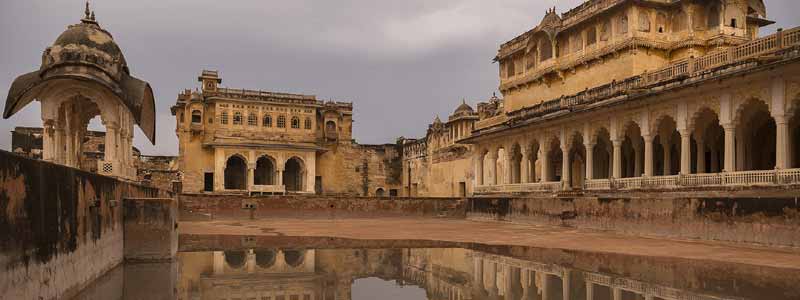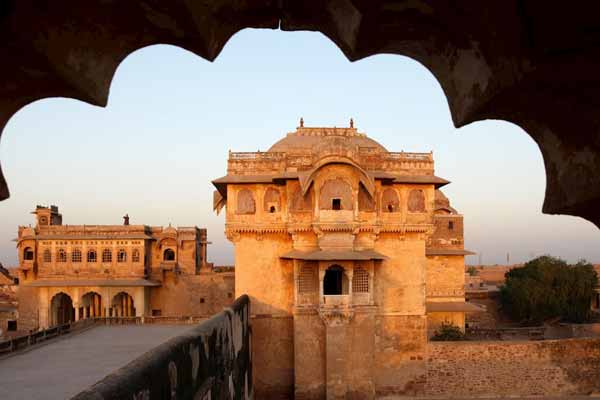Nagaur Fort, a magnificent structure located in the heart of Nagaur city in Rajasthan, India, is a testament to the region’s rich history and architectural brilliance. Spanning across an extensive area of about 2.5 kilometers, this fort stands proudly amidst the stark Thar Desert.
Constructed in the 12th century by the Nagavanshi dynasty, the fort underwent multiple expansions and renovations under various rulers, including the Ghaznavids, Mughals, and Rathores, showcasing diverse architectural styles. Its imposing walls, intricate carvings, and impressive bastions reflect the fusion of Rajput and Mughal architectural influences.
The fort’s layout comprises palaces, temples, mosques, and intricately designed courtyards, each narrating stories of valor, royalty, and cultural heritage. The massive pillars, delicately carved jharokhas (balconies), and beautiful frescoes add to its grandeur.
Notably, the fort hosts the renowned Sufi shrine of Sufi saint Hamiduddin Chisti, drawing devotees and tourists alike seeking blessings and serenity.
Visitors to Nagaur Fort are captivated by its historical significance, architectural splendor, and panoramic views of the surrounding desert. The fort stands as a living testament to Rajasthan’s glorious past, offering a glimpse into its rich cultural legacy and architectural prowess.

History of Nagaur Fort
The Nagaur Fort, also known as Ahhichatragarh Fort, has a rich history dating back to the 4th century. It was initially constructed by the Nagavanshi dynasty and underwent numerous expansions and renovations under different rulers.
The earliest mentions of the fort date back to the 4th century when it was ruled by the Nagas. Over time, it fell under the rule of various dynasties, including the Ghaznavids, Khiljis, and Rathores. It was during the reign of the Ghaznavids in the 12th century that significant fortifications and structures were added, expanding the fort’s size and enhancing its defensive capabilities, Nagaur Tour.
In the subsequent centuries, the fort came under the influence of the Delhi Sultanate and the Mughal Empire. During the Mughal era, the fort underwent further architectural developments, incorporating Mughal design elements into its structure. It became a prominent stronghold and witnessed several battles and changes in rulership.
The fort’s strategic location along ancient trade routes contributed to its significance as a military bastion and a center of cultural exchange. It also served as a seat of power for various Rajput clans and witnessed periods of prosperity and cultural flourishing, Rajasthan Monuments.
In addition to its military importance, the Nagaur Fort was a center of art, culture, and religious diversity. The presence of temples, mosques, palaces, and intricate architectural features within its walls attests to the cultural amalgamation that occurred over centuries.
Today, the Nagaur Fort stands as a remarkable architectural marvel, showcasing a blend of Rajput and Mughal influences. It serves as a tourist attraction and a reminder of Rajasthan’s glorious past, attracting visitors interested in history, architecture, and the cultural heritage of the region.
Attractions Inside Nagaur Fort
The Nagaur Fort, also known as Ahhichatragarh Fort, is an architectural marvel in Rajasthan, India, boasting various attractions within its sprawling complex:
Palaces and Structures: The fort houses several palaces that showcase exquisite Rajput and Mughal architecture. The Hadi Rani Mahal, Rani Mahal, and Deepak Mahal are among the palaces displaying intricate designs, stunning frescoes, and delicate carvings that reflect the opulence of the bygone eras.
Temples and Mosques: Within the fort’s premises, there are temples and mosques representing diverse religious influences. The Dadhimati Temple, dedicated to Goddess Dadhimati, is a significant site visited by devotees. Additionally, there are mosques such as Akbari Masjid, reflecting the Islamic architectural style.
Courtyards and Gardens: The fort contains numerous courtyards adorned with ornate pillars and carvings. These spaces were once bustling with courtly activities, festivals, and cultural events. The presence of gardens adds to the scenic beauty, offering serene spots within the fort.
Hamid Manzil: This section of the fort houses the shrine of Sufi saint Hamiduddin Chisti. It’s a revered site attracting devotees seeking blessings and spiritual solace.
Museum and Artifacts: The fort hosts a museum displaying a collection of artifacts, weapons, paintings, sculptures, and historical items that offer insights into the region’s cultural heritage and the fort’s history.
Architecture and Ramparts: The fort’s massive walls, bastions, and intricate architectural details, such as jharokhas (balconies), arches, and domes, are striking examples of Rajput and Mughal craftsmanship. The impressive ramparts offer panoramic views of the surrounding landscape.
Events and Festivals: Nagaur Fort serves as a venue for various cultural events and festivals, including the Nagaur Fair, which attracts people from far and wide to witness folk music, dance performances, cattle trading, and other traditional activities.
Visitors to the Nagaur Fort can immerse themselves in the historical significance, architectural beauty, and cultural richness preserved within its walls. The diverse array of attractions makes it a must-visit destination for history enthusiasts, architecture aficionados, and those intrigued by Rajasthan’s vibrant heritage.
Places to visit Near Nagaur Fort
Around Nagaur Fort, several attractions and places offer diverse experiences:
Khimsar Fort: Located about 50 kilometers from Nagaur, Khimsar Fort is a stunning heritage hotel. This fort-turned-hotel provides a glimpse into Rajasthan’s royal past, offering luxurious stays and desert experiences.
Kuchaman Fort: Roughly 100 kilometers away from Nagaur, Kuchaman Fort is a majestic structure perched atop a hill. It offers panoramic views of the town and houses ancient temples, palaces, and beautiful frescoes.
Osian: Known as the ‘Khajuraho of Rajasthan,’ Osian is renowned for its ancient temples, particularly the Sachiya Mata Temple and the Jain temples. It’s about 150 kilometers from Nagaur and is a significant religious and architectural site.
Deedwana: This town, approximately 90 kilometers from Nagaur, is famous for the Deedwana fort. The fort’s architectural beauty and historical significance make it an interesting stopover.
Merta: Merta, located around 70 kilometers away, is famous for the Meera Bai Temple and the historical Meera Mahal, associated with the life of the saint-poet Meera Bai.
Nagaur Cattle Fair: If timed right, visitors can experience the famous Nagaur Cattle Fair, one of the largest in Rajasthan. Held annually, it’s a vibrant event showcasing cattle trading, folk music, dance, and other cultural activities.
Exploring these nearby destinations offers a broader view of Rajasthan’s history, architecture, and cultural diversity, complementing the experience of visiting the magnificent Nagaur Fort.
How To Reach Nagaur Fort
Nagaur Fort, located in Nagaur city, Rajasthan, is accessible via various modes of transportation:
By Air: The nearest airport to Nagaur is in Jodhpur, approximately 135 kilometers away. From Jodhpur Airport, visitors can hire taxis or use bus services to reach Nagaur. Jodhpur Airport connects to major cities in India.
By Train: Nagaur has its own railway station, and regular trains connect it to cities like Jaipur, Jodhpur, Delhi, and others. From the Nagaur railway station, taxis and auto-rickshaws are available to reach the fort.
By Road: Nagaur is well-connected by roads and can be accessed via buses, taxis, or private vehicles. National Highway 65 passes through Nagaur, connecting it to major cities like Jaipur, Jodhpur, and Bikaner. State-run buses and private buses ply regularly between Nagaur and neighboring towns and cities.
Local Transportation: Once in Nagaur city, auto-rickshaws, taxis, and cycle-rickshaws are available for local transportation. These can be hired to reach Nagaur Fort, which is a prominent landmark in the city.
The fort is situated within the city, making it accessible and convenient for visitors arriving via different modes of transportation.
